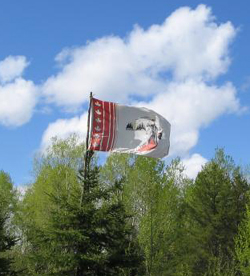Opposition to uranium mining has once again become a major topic of coverage by the media. From Australia to Canada, people are taking a stand against corporations that mine uranium and in particular against their mining on Native land. Today, the Ardoch and Shabot blockade brings attention to the potential uranium mine opening between Kingston and Ottawa. To make it clearer why so many are objecting to the mining of uranium, I have decided to investigate why so many are mining it in the first place.
Processed uranium is used for nuclear energy and weapons. Previously it was recycled, largely from old Soviet nuclear weapons. This source has now run out and in recent years the price of uranium skyrocketed from $7 to $145 per pound, according to the Colorado Springs Business Journal. In North America, U.S. uranium mining is concentrated in Colorado while Canadian mining in northern Saskatchewan and Ontario. Its processing, called “enrichment,” leaves behind a depleted form of uranium (DU), used both for military and non-military (civilian) purposes. These include anti-tank artillery and coating of medical equipment such as x-ray and gamma radiation technology. The American military used DU in Iraq, the Former Republic of Yugoslavia, and in Afghanistan releasing close to 900 tones into the environment.
The radioactive toxicity of weapons-grade and energy-grade uranium has now seeped into common knowledge. Beyond radioactivity, though, uranium has enormous impacts on human health and has faced brutal criticism from the scientific community. Similar criticism was given to the disposal and the processing of uranium. Nonetheless, little media and government attention has been given to the effects of uranium mining in particular.
While decaying, uranium emits alpha, beta, and gamma radiation. When this radiation enters the body it lead to an increased risk of cancers, according to the U.S. Environmental Protection Agency (EPA). By releasing this radiation, uranium decomposes, but so slowly that it takes over 760 million years to half in size. With a footprint like that, the effects of its mining, processing, use, and disposal have an unfathomable and effectively permanent impact on all life.
Unlike popular belief, uranium is mostly dangerous in its gross form, not because of its radioactivity. Once it or its depleted form enter the body through airways or the digestive tract, a number of harmful medical effects begin. In fact, visualizing this is easiest at sites of uranium mining, as miners are directly exposed to the resulting silica dust, and residents in areas neighboring the mines are exposed to contamination from the pollution of their water or air. “Aboriginal communities suffer very distinctly from the mining because they are remote from urban centres and experience the effects firsthand,” informed me Marlene Laroque of the National Aboriginal Health Organization. “These communities don’t have as many resources as urban centres do to clean up the pollution.”
Because of the location of the mines, there have been a disproportionate number of aboriginal workers as compared to those in other industries. Aboriginal communities are not only the ones suffering the brunt of the damage, but are also demonstrative of the significance of the effects. Navajo Aboriginals in the U.S. for example historically had a significantly low incidence of lung cancers. In their population the skyrocketing of lung cancers in uranium miners of the 1950s really brought home the point. Further, a 1949 discovery in the United States linked the elevated lung cancer rates with inhaled radon gas particles. This, though, did not push the government to create regulations or impose bans on the mining industry even though studies have been demonstrating these results since the 1920s and 1930s. Over 20% of the miners in that period were Navajos as are Métis in Canada today.
Along with the environmental pollution that ensues, social and political effects follow. This is especially true of aboriginal communities as their lives are more directly linked with nature. According to Marlene Laroque, this means that their lives are directly impacted by resource extraction. [The corporations] “clear-cut for roads, and go into lakes and rivers. This leads to degradation of the traditional living and hunting territories because the food supply is contaminated and access is limited.”
The food cycle leads to people internalizing the extracted compounds through consuming contaminated fish or game. Once inside the body, uranium changes physiology beginning with kidney damage (termed “nephrotoxicity”). Medically it works something like this: a toxic substance enters the body, the body tries to get rid of the substance, and the body’s drainage system becomes disrupted and clogged up. In the case of uranium mining, this substance is often radon, a byproduct of the mining itself. Radon has a long ugly history in medical research for causing multiple myelomas: otherwise called Kahler’s Disease. Here, immune cells of the bone marrow, normally producing antibodies, become cancerous.1 The effect of this, according to the Canadian Cancer Society, is infection of organs, weakness, confusion, bone pain, anemia, and potential loss of bowel or bladder control. Other symptoms are carpal tunnel, diseasing of the body’s nerves, and leukemia.2
When dust produced from mining uranium is inhaled the first impacted organ is the lung. Cancerous effects are particularly significant here because cells reproduce often and continuously. Interrupting this delicate balance means cells begin forming tumors, which explains the high level of lung cancers among uranium miners.3 Other organs demonstrating elevated cancers in uranium miners are gallbladder and bile duct.4
Studies on animals have been confirming the human trends. Multiple international laboratories have shown that uranium builds up in the brain.5 This buildup leads to the brain’s chemical messengers, thanks to which the brain gets thrown completely out of balance.
Other studies, such as that performed by Spanish scientists of the Rovira i Virgili University confirmed others’ results. Their experiment on rats has shown not only the previously studied kidney damage but also that uranium disrupts the chemical balance of the body.6 An interesting outcome of their research is not only confirmation of almost 90 years of scientific inquiry but their discovery of melatonin as treatment for uranium toxicity. Though remarkable, it is a band-aid solution that reduces kidney damage in rats exposed to contaminated water but fails to restore the chemical balance disrupted in the first place. This damage is irreparable.
Also worrisome is contamination passed through water. A contaminated water-well in rural Northwestern Connecticut from which young children had accidentally drunk. Levels of uranium in the water were measured to be almost 40 times higher than the EPA classifies as toxic. Some children took over 3 months to recover.7
Colorado’s Navahos have spearheaded resistance against such pollutions. The only tangible reprieve for their suffering came in 1952 when the Atomic Energy Commission recommended mining ventilation, but it has done nothing to pressure corporations to obey. Ventilation of uranium mines only begun in 1967 at Union Carbide and did not become universal as even the government agencies claimed it was too costly. Legal battles took decades to resolve. Some of these include lawsuits against the Nuclear Regulatory Commissions for its neglect of the miners’ health despite its knowledge of the danger of their occupational exposure. For consolation, the Radiation Exposure Compensation Act was created, which allocated $100,000 to each of the miners’ families. This caused a temporary drawdown in Colorado’s uranium mining industry and shifted some of the production to Canada. According to Natural Resources Canada, we now produce 29% of the world’s uranium.
The growth of the Canadian industry is a response to commercial profit-making opportunities. A decrease in supply plus an increase in demand equals higher prices. In the face of the horrendous, effectively permanent destructiveness to current and future generations, the continual extraction of uranium is dumbfounding. It is a demonstration of the corporate world’s war against nature and marginalized communities. This war, destructive to all communities, is exemplified by a classist separation between those who benefit from uranium mining, the corporations, and those who significantly suffer from it, the working class and aboriginal communities. From Russia to China, Australia to Canada, uranium is mined globally, and its impact on the world accumulates. In response to this, the struggle of those who dare to rise up against all odds is to be celebrated and supported. The resistance must spread faster than the pollution.
1 L. Tomasek, E. Kunz, S.C. Darby, A. J. Swerdlow, V. Placek, “Radon Exposure and Cancers Other than Lung Cancer among Uranium Miners in West Bohemia,” The Lancet 341.8850 (April 1993), pp. 919-923.
2 Ibid.
3 A. V. Malashenko, “The Lung Cancer in the Uranium Miners of Sedimentary Deposits,” Meditsinskaya Radiologiya i Radiatsionnaya Bezolasnost 60.6 (2005), pp. 10-12.
4 Tomasek, et al., op. cit.
5 V. Linares, D. J. Sanchez, M. Belles, L. Albine, M. Gomez, J. K. Domingo, “Pro-oxidant Effects in the Brain of Rats Concurrently Exposed to Uranium and Stress,” Toxicology Journal 236.1-2 (July 2007), pp. 82-91.
6 M. Belles, V. Linares, M. Luisa-Albina, J. Sirvent, D. Sanchez, and J.L. Domingo, “Melatonin Reduces Uranium Induced Nephrotoxicity in Rats,” Journal of Pineal Research 43.1 (August 2007), pp.87-95
7 H.S. Magdo, J. Forman, N. Graber, B. Newman, K. Klein, L. Satlin, R. W. Amler, J. A. Winston, P. J. Landrigan, “Grand Rounds: Nephrotoxicity in a Young Child Exposed to Uranium from Contaminated Well-Water,” Environmental Health Perspectives 115. 8 (August 2007), pp.1237-41.
Lia Tarachansky is a science journalist.
|
| Print


